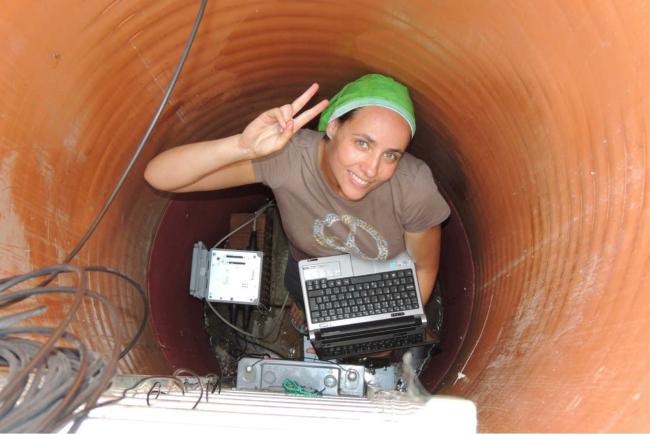
Office email
Office Phone
Department
Building No. 1
D
Floor No. 1
2
My main focus is on the active seismic zones in the Western Carpathians.
I am responsible for building and maintaining an extension of the local seismic network MKnet.
My research deals with data analysis, focused on moment tensor inversion, developing of seismic models and seismic events location.
https://publons.com/researcher/2521524/lucia-fojtikova/
1. Fojtíková, L., Zahradník, J. (2014). A new strategy for weak events in sparse networks: the first-motion polarity solutions constrained by single-station waveform inversion. Seismological
Research Letters, vol. 85, no. 6, 1265-1274. DOI: 10.1785/0220140072
2. Fojtíková, L., Vavryčuk, V., Cipciar, A., Madarás, J. 2010: Focal mechanisms of micro-earthquakes in the Dobrá Voda seismoactive area in the Malé Karpaty Mts (Little Carpathians), Slovakia. Tectonophysics. 492, 213-229. doi:10.1016/j. tecto.2010.06.007
3. Fojtíková, L. & Vavryčuk, V.: Tectonic stress regime in the 2003–2004 and 2012–2015 earthquake swarms in the Ubaye Valley, French Alps. Pure Appl. Geophys. (2018). https://doi.org/10.1007/s00024-018-1792-2
4. Fojtíková Lucia, Miriam Kristeková, Jiří Málek, Efthimios Sokos, Kristián Csicsay, Jiří Zahradník (2016). Quantifying capability of a local seismic network in terms of locations and focal mechanism solutions of weak earthquakes, Journal of Seismology, vol 20, 93-106
5. Zahradník, J., Fojtíková, L., Carvalho,J., Barros, L.V., Sokos, E., Janský, J.( 2015). Compromising polarity and waveform constraints in focal-mechanism solutions; the Mara Rosa 2010 Mw 4 central Brazil earthquake revisited. Journal of South American Earth Sciences 63 (2015) 323-333.
6. Marko, F., Andriessen, P.A.M., Tomek, Č., Bezák, V., Fojtíková, L., Bošanský, M., Piovarči, M., Reichwalder, P. Carpathian Shear Corridor – A strike-slip boundary of an extruded crustal segment (2017) Tectonophysics, 703-704, pp. 119-134; DOI: 10.1016/j.tecto.2017.02.010
7. Lukešová R., Fojtíková L., Málek J., Kolínský P., 2019: Seismic Waves Velocities Inferred From The Surface Waves Dispersion In The Malé Karpaty Mountains, Slovakia. Acta Geodyn. Geomater., Vol. 16, No. 4 (196), 451–464, DOI: 10.13168/AGG.2019.0019
8. Petronis, M., Valenta, J., Rapprich, V., Lindline, J., Heizler, M., van Wyk de Vries, B., Shields S., Balek, J., Fojtíková, L., Tábořík, P. (2018). Emplacement history of the Miocene Zebín tuff cone (Czech Republic) revealed from ground geophysics, anisotropy of magnetic susceptibility, paleo-magnetic, and 40Ar/39Ar geochronology data. Geochemistry, Geophysics, Geosystems, 19. https://doi.org/10.1029/2017GC007324
9. Valenta J., Rapprich V., Skácelová Z., Gaždová R., Fojtíková L. (2014a) The newly discovered neogene maar volcano near the Mariánské Lázně, western Bohemia. Acta Geodynamica et Geomaterialia, vol. 11, no. 2., 107–116. DOI: 10.13168/AGG.2013.0061
10. Valenta J., Rapprich V., Stárková M., Skácelová Z., Fojtíková L., Staněk F., Balek J. (2014b). Problems and challenges in detection of pre-Mesozoic maar volcanoes: example from the Principálek Volcano in the Permian Krkonoše Piedmont Basin. Journal of Geosciences, 59, 169–181.
11. Briestenský, M., Košťák, B., Stemberk, J., Petro, Ľ., Vozár, J., Fojtíková, L. 2010: Active tectonic fault microdisplacement analyses: a comparison of results from surface and underground monitoring in Western Slovakia. Acta Geodyn. Geomater., Vol. 7, No. 4 (160), 387–397, 2010.
12. Kristeková, M., Moczo, P., Labák, P., Cipciar, A., Fojtíková, L., Madarás, J. & Kristek, J. 2008: Time – Frequency Analysis of Explosions in the Ammunition Factory in Novaky, Slovakia. Bulletin of the Seismological Society of America. ISSN 0037-1106, vol. 98, no. 5, pp 2507-2516.
Research Letters, vol. 85, no. 6, 1265-1274. DOI: 10.1785/0220140072
2. Fojtíková, L., Vavryčuk, V., Cipciar, A., Madarás, J. 2010: Focal mechanisms of micro-earthquakes in the Dobrá Voda seismoactive area in the Malé Karpaty Mts (Little Carpathians), Slovakia. Tectonophysics. 492, 213-229. doi:10.1016/j. tecto.2010.06.007
3. Fojtíková, L. & Vavryčuk, V.: Tectonic stress regime in the 2003–2004 and 2012–2015 earthquake swarms in the Ubaye Valley, French Alps. Pure Appl. Geophys. (2018). https://doi.org/10.1007/s00024-018-1792-2
4. Fojtíková Lucia, Miriam Kristeková, Jiří Málek, Efthimios Sokos, Kristián Csicsay, Jiří Zahradník (2016). Quantifying capability of a local seismic network in terms of locations and focal mechanism solutions of weak earthquakes, Journal of Seismology, vol 20, 93-106
5. Zahradník, J., Fojtíková, L., Carvalho,J., Barros, L.V., Sokos, E., Janský, J.( 2015). Compromising polarity and waveform constraints in focal-mechanism solutions; the Mara Rosa 2010 Mw 4 central Brazil earthquake revisited. Journal of South American Earth Sciences 63 (2015) 323-333.
6. Marko, F., Andriessen, P.A.M., Tomek, Č., Bezák, V., Fojtíková, L., Bošanský, M., Piovarči, M., Reichwalder, P. Carpathian Shear Corridor – A strike-slip boundary of an extruded crustal segment (2017) Tectonophysics, 703-704, pp. 119-134; DOI: 10.1016/j.tecto.2017.02.010
7. Lukešová R., Fojtíková L., Málek J., Kolínský P., 2019: Seismic Waves Velocities Inferred From The Surface Waves Dispersion In The Malé Karpaty Mountains, Slovakia. Acta Geodyn. Geomater., Vol. 16, No. 4 (196), 451–464, DOI: 10.13168/AGG.2019.0019
8. Petronis, M., Valenta, J., Rapprich, V., Lindline, J., Heizler, M., van Wyk de Vries, B., Shields S., Balek, J., Fojtíková, L., Tábořík, P. (2018). Emplacement history of the Miocene Zebín tuff cone (Czech Republic) revealed from ground geophysics, anisotropy of magnetic susceptibility, paleo-magnetic, and 40Ar/39Ar geochronology data. Geochemistry, Geophysics, Geosystems, 19. https://doi.org/10.1029/2017GC007324
9. Valenta J., Rapprich V., Skácelová Z., Gaždová R., Fojtíková L. (2014a) The newly discovered neogene maar volcano near the Mariánské Lázně, western Bohemia. Acta Geodynamica et Geomaterialia, vol. 11, no. 2., 107–116. DOI: 10.13168/AGG.2013.0061
10. Valenta J., Rapprich V., Stárková M., Skácelová Z., Fojtíková L., Staněk F., Balek J. (2014b). Problems and challenges in detection of pre-Mesozoic maar volcanoes: example from the Principálek Volcano in the Permian Krkonoše Piedmont Basin. Journal of Geosciences, 59, 169–181.
11. Briestenský, M., Košťák, B., Stemberk, J., Petro, Ľ., Vozár, J., Fojtíková, L. 2010: Active tectonic fault microdisplacement analyses: a comparison of results from surface and underground monitoring in Western Slovakia. Acta Geodyn. Geomater., Vol. 7, No. 4 (160), 387–397, 2010.
12. Kristeková, M., Moczo, P., Labák, P., Cipciar, A., Fojtíková, L., Madarás, J. & Kristek, J. 2008: Time – Frequency Analysis of Explosions in the Ammunition Factory in Novaky, Slovakia. Bulletin of the Seismological Society of America. ISSN 0037-1106, vol. 98, no. 5, pp 2507-2516.
